 Germany (1898)
Germany (1898)SMS Gazelle, Niobe, Nymphe, Thetis, Ariadne, Amazone, Medusa, Frauenlob, Arcona, Undine
WW1 German Cruisers
Irene class | SMS Gefion | SMS Hela | SMS Kaiserin Augusta | Victoria Louise class | Prinz Adalbert class | SMS Prinz Heinrich | SMS Fürst Bismarck | Roon class | Scharnhorst class | SMS BlücherBussard class | Gazelle class | Bremen class | Kolberg class | Königsberg class | Nautilus class | Magdeburg class | Dresden class | Graudenz class | Karlsruhe class | Pillau class | Wiesbaden class | Karlsruhe class | Brummer class | Königsberg ii class | Cöln class
The first modern light cruisers:
The Gazelle class has been often dubbed as the “first modern light cruisers”. They had indeed all the trademark of the type and formed the basis for Germany of a long lineage which will go straight through ww1 and the interwar, and culminated with the KMS Nürnberg in 1937.
The Gazelle were started from 1898 to 1902 at Germaniawerft (3 ships), Weser (4), Dantzig Dyd (Thetis), and Howaldswerke (Undine) and launched between March 1898 and December 1902. The class comprised the Gazelle, Niobe, Nymphe, Thetis, Ariadne, Amazone, Medusa, Frauenlob, Arcona and Undine, all in service between June 1900 and January 1904. Their fate varied heavily, but three were lost in action in ww1.
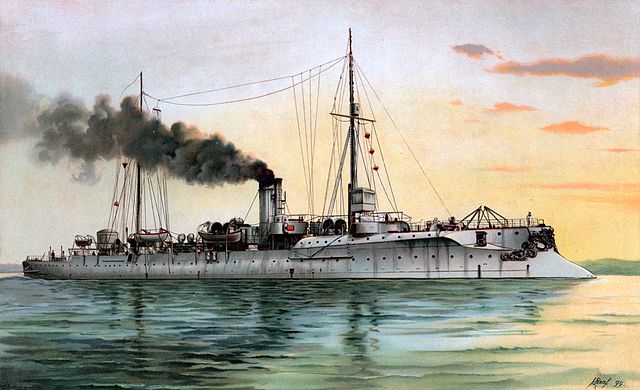
SMS Hela
Origins and inspiration: From aviso to light cruiser
Precursors has been an aviso (sort of fast, slim gunboats for colonial service), Hela (1895), Gefion, a unique cruiser-corvette or 3rd rate cruiser (1893), Meteor class avisos (1888), Wacht class (1887) while the Greif (1886), Blitz class (1882), Zieten (1876) were composite ships.
The SMS Gefion was probably the greatest inspiration for the Gazelle, with a rather tall hull and ten 105 mm guns. Interestingly, she was reduced as an accommodation ship from 1916 and converted as a merchantmen in 1920, so bad was German shipping then.
She not very successful as a frail, light and narrow military ship would be for that purpose. The term “aviso” is French, meaning a “dispatch vessel”. This originated as a kind of small, light, very fast ship that passed admiral’s detailed orders to specific ships of the line while in battle, since signals then would be hard to catch amidst the explosions and smoke.
The term was kept as a tradition well into the end of XXth Century (through the cold war) but had little meaning in a modern context. Corvettes and Frigates replaced them.
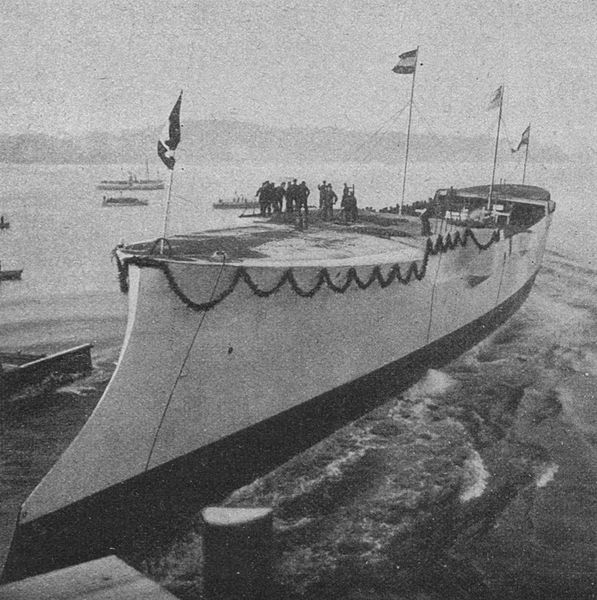
SMS Undine launch in 1902
Design of the Gazelle
These so-called “4th class” cruisers were in fact defined as good compromises between fast, large colonial gunboats (avisos) and squadron scouts.
They had some similarities with the Hela (1895), but their stern was raised to form a forecastle, and their armament was markedly reinforced. Instead of the few 88 mm, a battery of 10 pieces of 105 mm to deal with TBs and destroyers, like the Gefion.
They were also better protected with an armoured deck, but used the same powerplant than the Hela. In the end, these ships were well armed and able to assume their role of destroyers hunters, wile being able to deal with opposite cruisers.
The Gazelle were also recognizable at their two funnels, and their old fashioned rams. However the lead ship, SMS gazelle differed in two points from her sister-ships: She has a bow TT and above water side TTs, while the others had only submerged TTs.
Not only that, but she also had her charthouse placed between her two funnels, whole the others had it in front of the forefunnel.
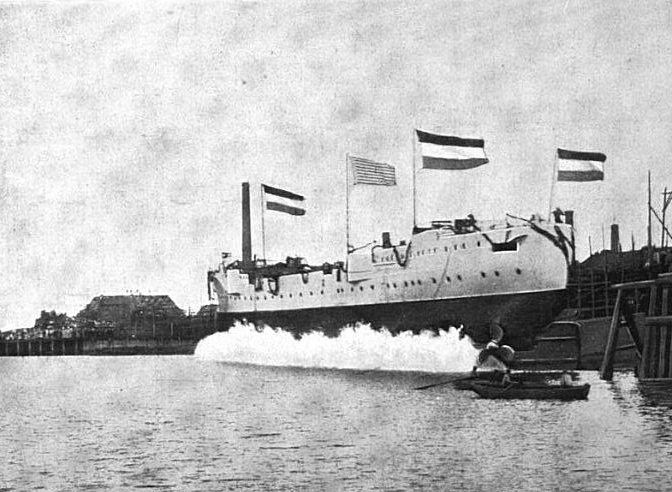
SMS Niobe launch
Armour
The main protective deck was 50mm (2in) amidships. The deck otherwise was 20 to 25 mm (0.79 to 0.98 in). Construction of the hull comprised transverse and longitudinal steel frames, and wooden planks covered with Muntz metal (to prevent fouling) up to a meter above the waterline. Twelve watertight compartments and a double bottom for 40% of the length prevented flooding.
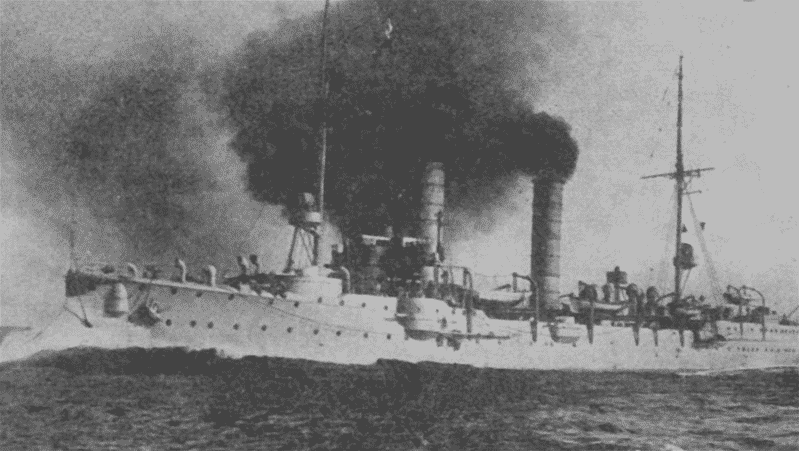
SMS Undine at full speed
Armament
The Germans thought lighter 105mm were best suited due to their rate of fire to deal with TBs and destroyers rather than the usual 6-in gus found previously on those kind of ships. This was not either the too light battery of 88mm guns found on the Hela.
These ten 10.5 cm SK L/40 guns were placed fore and aft in pairs (4) then followed six in sponsons, the further aft and rear being enclosed. Their range was 12,200 m (40,000 ft) and they were supplied with 100 rounds each. There were also ten machine-guns and two 450 mm (17.7 in) TTs with five torpedoes in reserve.
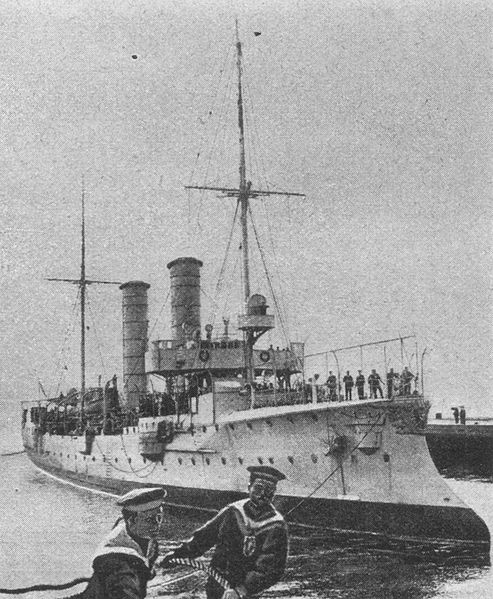
SMS Niobe in 1902
Powerplant
Gazelle, the lead ship differed from the others in having 2 shafts, 2 triple expansion engines for 6,000 ihp (4,500 kW). The others’s triple expansion engines developed 8,000 ihp (6,000 kW).
Speed for the first was 19.5 knots (36.1 km/h; 22.4 mph), and the others 21.5 knots (39.8 km/h; 24.7 mph). Their range was 3,560 to 4,400 nmi (6,590 to 8,150 km; 4,100 to 5,060 mi). Although agile these ships tended to roll severely, being wet and to suffer from lee helm after modernization.
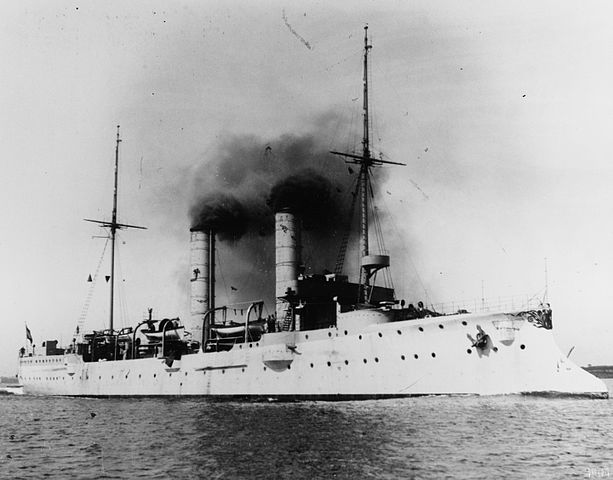
SMS Niobe at Kiel in 1903
Service
All ships served either, or in succession as fleet reconnaissance force, and on foreign stations. by 1914 they were in reserve due to their age. Gazelle has been reconstructed in 1905-1907 and Arcona in 1911-1912 but with apparently little change.
Earlier ships were used for coastal defence with reduced crews. In 1916, they were in second-line duties or even disarmed. Arcona was used as a minelayer (200 mines).
Fate
-SMS Ariadne participated in the Battle of Heligoland in August 1914 and was sunk there.
-SMS Undine was torpedoed in the Baltic by the E19 and the Frauenlob sank during the Battle of Jutland, torpedoed by the cruiser HMS Southampton.
Post War Career
The Gazelle was broken up in 1920, but the others survived for a while. The Nymph, Niobe and Amazon were completely rebuilt (new clipper prow, 500 mm TTs) and served until 1931-32, the first being sold to the Yugoslavs, renamed Dalmacija in 1925 and then was captured by the Italians in 1941 and renamed Cattaro.
She was then used with a new armament of 6x 8.5 in Skoda guns and 6×20 mm Breda guns until 1943. Form then on she was recaptured by the Germans and used a short time before being transferred to the puppet Croatian regime, and back again German control when she was sunk by British MTBs 276 and 298 in the Adriatic in 22/12/1943.
Nymphe was struck off in 1931 but Amazone went on as an accomodation huk until 1954, while Medusa and Arcona were taken in hands for rebuilding as Flak ships in 1942. In this new configuration they had five 105 mm AA, 2×35 mm and 4×20 mm guns. They survived the war and were eventually broken up in 1948.
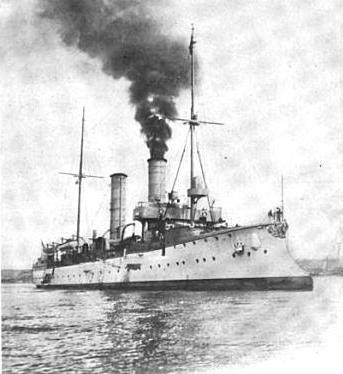
SMS Amazone in 1903
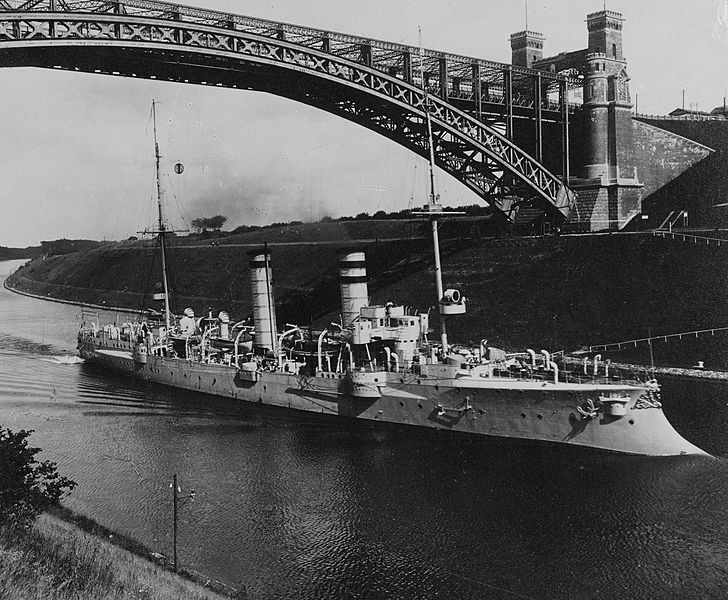
SMS Frauenlob in Kiel canal
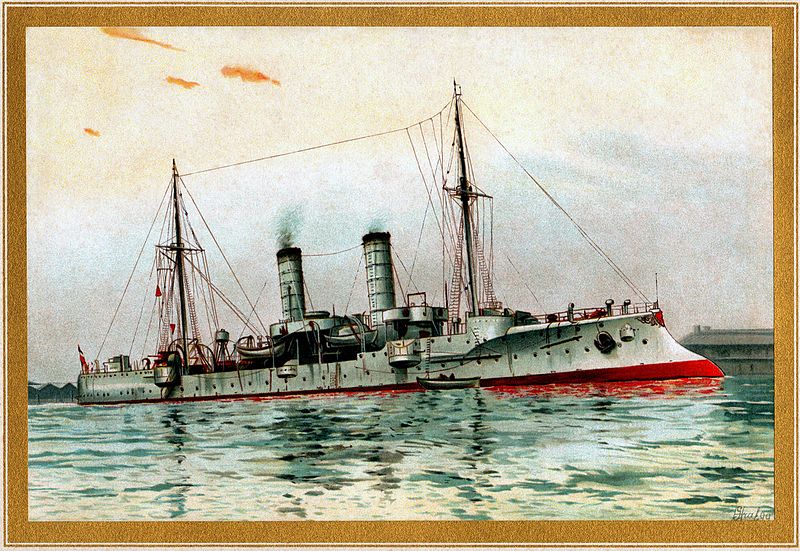
Nice lithography of the Gazelle in 1902
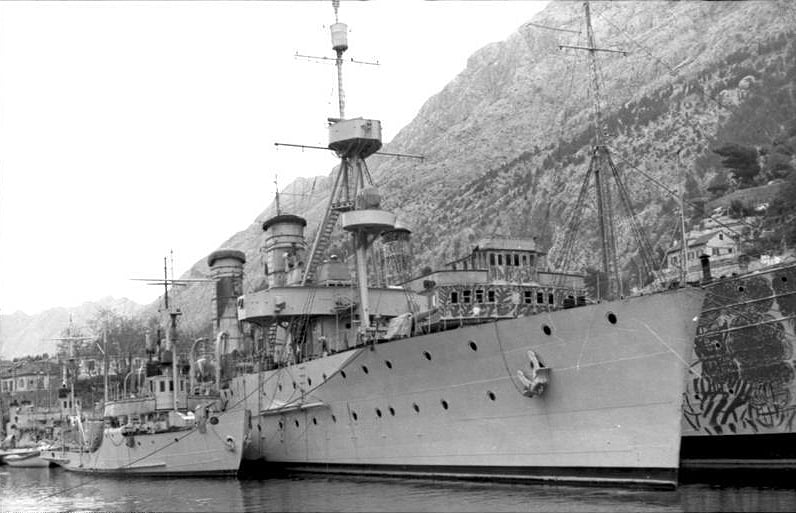
Ex-Niobe (Dalmacija) in Yougoslav service
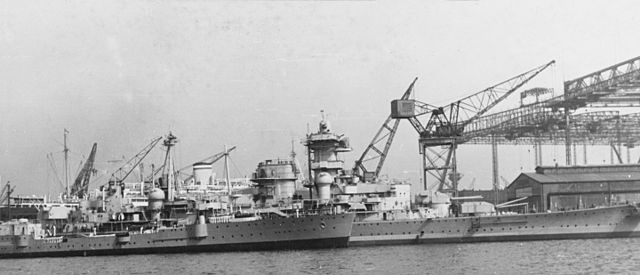
Amazone and Hipper at Blohm & Voss in 1939
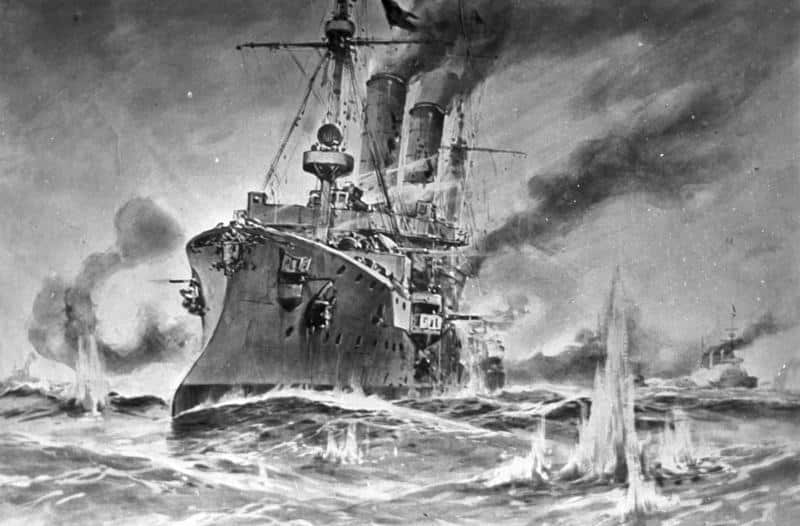
SMS Ariadne at Heligoland in 1914
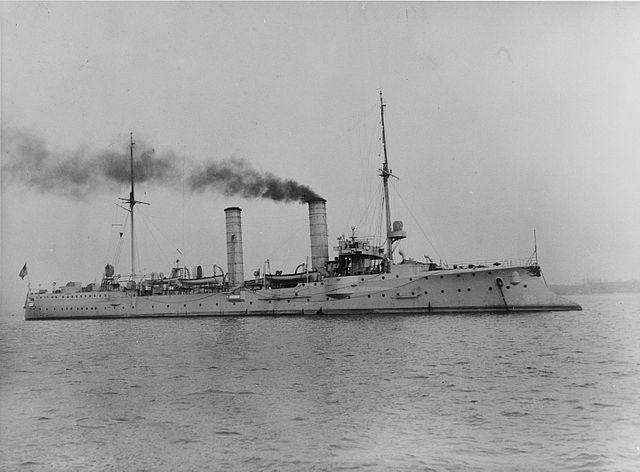
SMS Amazone at anchor
Links
The Gazelle class on wikipedia
naval-encyclopedia.com/ww1/pages/hochseeflotte/gazelle.htm
Specs Conway’s all the world fighting ships 1921-1947.
Gazelle class specifications |
|
| Dimensions | 105 x12.2 x5.4 m |
| Displacement | 2916/3013/3130t/t FL |
| Crew | 249-259 |
| Propulsion | 2 shafts, 2 VTE engines, 6 boilers, 8500-9000 ihp |
| Speed | 20-21.5 (Niobe 22) knots |
| Range | 4400 nmi at 19 knots |
| Armament | 10x 105 mm, 8x 8mm MGs, 2x 450mm TTs. |
| Armor | Decks 20-25 mm belt 50 mm |
Gallery
Illustration of the SMS Gazelle by the author, as built in 1901.

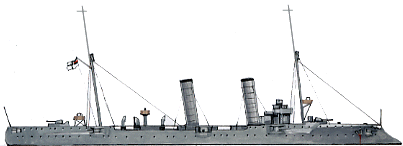
 Latest Facebook Entry -
Latest Facebook Entry -  X(Tweeter) Naval Encyclopedia's deck archive
X(Tweeter) Naval Encyclopedia's deck archive Instagram (@navalencyc)
Instagram (@navalencyc)





 French Navy
French Navy Royal Navy
Royal Navy Russian Navy
Russian Navy Armada Espanola
Armada Espanola Austrian Navy
Austrian Navy K.u.K. Kriegsmarine
K.u.K. Kriegsmarine Dansk Marine
Dansk Marine Nautiko Hellenon
Nautiko Hellenon Koninklije Marine 1870
Koninklije Marine 1870 Marinha do Brasil
Marinha do Brasil Osmanlı Donanması
Osmanlı Donanması Marina Do Peru
Marina Do Peru Marinha do Portugal
Marinha do Portugal Regia Marina 1870
Regia Marina 1870 Nihhon Kaigun 1870
Nihhon Kaigun 1870 Preußische Marine 1870
Preußische Marine 1870 Russkiy Flot 1870
Russkiy Flot 1870 Svenska marinen
Svenska marinen Søværnet
Søværnet Union Navy
Union Navy Confederate Navy
Confederate Navy Armada de Argentina
Armada de Argentina Imperial Chinese Navy
Imperial Chinese Navy Marinha do Portugal
Marinha do Portugal Mexico
Mexico Kaiserliche Marine
Kaiserliche Marine 1898 US Navy
1898 US Navy Sovietskiy Flot
Sovietskiy Flot Royal Canadian Navy
Royal Canadian Navy Royal Australian Navy
Royal Australian Navy RNZN Fleet
RNZN Fleet Chinese Navy 1937
Chinese Navy 1937 Kriegsmarine
Kriegsmarine Chilean Navy
Chilean Navy Danish Navy
Danish Navy Finnish Navy
Finnish Navy Hellenic Navy
Hellenic Navy Polish Navy
Polish Navy Romanian Navy
Romanian Navy Turkish Navy
Turkish Navy Royal Yugoslav Navy
Royal Yugoslav Navy Royal Thai Navy
Royal Thai Navy Minor Navies
Minor Navies Albania
Albania Austria
Austria Belgium
Belgium Columbia
Columbia Costa Rica
Costa Rica Cuba
Cuba Czechoslovakia
Czechoslovakia Dominican Republic
Dominican Republic Haiti
Haiti Hungary
Hungary Honduras
Honduras Estonia
Estonia Iceland
Iceland Eire
Eire Equador
Equador Iran
Iran Iraq
Iraq Latvia
Latvia Liberia
Liberia Lithuania
Lithuania Mandchukuo
Mandchukuo Morocco
Morocco Nicaragua
Nicaragua Persia
Persia San Salvador
San Salvador Sarawak
Sarawak Uruguay
Uruguay Venezuela
Venezuela Zanzibar
Zanzibar Warsaw Pact Navies
Warsaw Pact Navies Bulgaria
Bulgaria Hungary
Hungary

 Bundesmarine
Bundesmarine Dutch Navy
Dutch Navy Hellenic Navy
Hellenic Navy Marina Militare
Marina Militare Yugoslav Navy
Yugoslav Navy Chinese Navy
Chinese Navy Indian Navy
Indian Navy Indonesian Navy
Indonesian Navy JMSDF
JMSDF North Korean Navy
North Korean Navy Pakistani Navy
Pakistani Navy Philippines Navy
Philippines Navy ROKN
ROKN Rep. of Singapore Navy
Rep. of Singapore Navy Taiwanese Navy
Taiwanese Navy IDF Navy
IDF Navy Saudi Navy
Saudi Navy Royal New Zealand Navy
Royal New Zealand Navy Egyptian Navy
Egyptian Navy South African Navy
South African Navy






























 Ukrainian Navy
Ukrainian Navy dbodesign
dbodesign